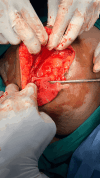A Rare Case of Grynfeltt-Lesshaft Hernia in an Elderly Patient
- PMID: 40385780
- PMCID: PMC12085966
- DOI: 10.7759/cureus.82517
A Rare Case of Grynfeltt-Lesshaft Hernia in an Elderly Patient
Abstract
Lumbar hernia, a rare and challenging condition in which abdominal contents protrude through defects in the posterolateral abdominal wall, has been recognized since the 17th century. It typically involves two key anatomical regions: the superior lumbar triangle (Grynfeltt-Lesshaft) and the inferior lumbar triangle (Petit). Due to the limited number of documented cases, a deep understanding of the specific anatomy and weaknesses in the lumbar region is crucial for accurate diagnosis and management. Diagnosing lumbar hernias can be difficult, often leading to misdiagnosis as lipomas or abscesses. Clinically, hernias present as bulges that tend to become more prominent with physical activity. A contrast-enhanced CT scan is essential for preoperative evaluation, though certain anatomical variations can complicate diagnosis. Surgical options include traditional open repairs and minimally invasive laparoscopic techniques, with mesh placement being commonly used. The choice of approach must be individualized, considering the hernia's size, contents, and the patient's overall condition. Despite advancements, achieving optimal outcomes remains challenging due to the complexity of the involved anatomy. Whether congenital or acquired, a Grynfeltt-Lesshaft hernia requires heightened awareness and a solid understanding of lumbar anatomy for early diagnosis. In resource-limited settings, open repair may be the most practical surgical approach. Effective management relies on a comprehensive clinical evaluation and the selection of the appropriate surgical technique to minimize recurrence and ensure the best possible patient outcomes.
Keywords: grynfelt-lesshaft hernia; grynfelt-lesshaft hernia repair; hernia; lumbar hernia; open hernia surgery.
Copyright © 2025, Ganesan et al.
Conflict of interest statement
Human subjects: Consent for treatment and open access publication was obtained or waived by all participants in this study. Conflicts of interest: In compliance with the ICMJE uniform disclosure form, all authors declare the following: Payment/services info: All authors have declared that no financial support was received from any organization for the submitted work. Financial relationships: All authors have declared that they have no financial relationships at present or within the previous three years with any organizations that might have an interest in the submitted work. Other relationships: All authors have declared that there are no other relationships or activities that could appear to have influenced the submitted work.
Figures






Similar articles
-
Primary Jean Louis Petit and Grynfeltt-Lesshaft concomitant hernias: A case report.Int J Surg Case Rep. 2018;51:1-4. doi: 10.1016/j.ijscr.2018.07.040. Epub 2018 Aug 10. Int J Surg Case Rep. 2018. PMID: 30121395 Free PMC article.
-
The role of ultrasound in the diagnosis of Grynfeltt-Lesshaft lumbar hernia: A case report.Australas J Ultrasound Med. 2021 Jun 26;24(3):178-180. doi: 10.1002/ajum.12276. eCollection 2021 Aug. Australas J Ultrasound Med. 2021. PMID: 34765428 Free PMC article.
-
Robotic-Assisted Laparoscopic Repair of Petit's Hernia With Preperitoneal Mesh.Cureus. 2024 Jul 3;16(7):e63771. doi: 10.7759/cureus.63771. eCollection 2024 Jul. Cureus. 2024. PMID: 38966780 Free PMC article.
-
Renal pelvis and ureteropelvic junction incarceration in a Grynfeltt-Lesshaft hernia: a case report and review of the literature.BMC Urol. 2020 Jun 25;20(1):74. doi: 10.1186/s12894-020-00626-1. BMC Urol. 2020. PMID: 32586385 Free PMC article. Review.
-
Grynfeltt-Lesshaft hernia Personal experience of nine cases and a review of the literature.Ann Ital Chir. 2022;93:698-701. Ann Ital Chir. 2022. PMID: 36617279 Review.
References
-
- Petit's lumbar hernia: repair with Marlex mesh. Hafner CD, Wylie JH, Brush BE. Arch Surg. 1963;86:180–186. - PubMed
-
- Controversies in the current management of lumbar hernias. Moreno-Egea A, Baena EG, Calle MC, Martínez JA, Albasini JL. Arch Surg. 2007;142:82–88. - PubMed
-
- Lumbar hernia: anatomical basis and clinical aspects. Armstrong O, Hamel A, Grignon B, NDoye JM, Hamel O, Robert R, Rogez JM. Surg Radiol Anat. 2008;30:533–537. - PubMed
-
- Laparoscopic retroperitoneal repair of recurrent postoperative lumbar hernia. Woodward AM, Flint LM, Ferrara JJ. J Laparoendosc Adv Surg Tech A. 1999;9:181–186. - PubMed
-
- Laparoscopic repair of a traumatic lumbar hernia: a case report. Burick AJ, Parascandola SA. J Laparoendosc Surg. 1996;6:259–262. - PubMed
Publication types
LinkOut - more resources
Full Text Sources
